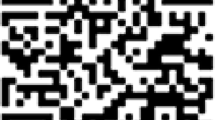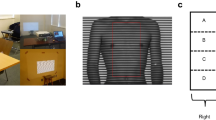Abstract
Introduction and hypothesis
The aim of this pilot study was to demonstrate physiological movements of the muscular walls surrounding the abdominal cavity during breathing and coughing in healthy nulliparous women by means of real-time dynamic magnetic resonance imaging (MRI).
Methods
Eight volunteers underwent MRI measurements in a 1.5-T whole body MR-scanner. Coronal and sagittal slices were acquired simultaneously to assess respiratory-related cranio-caudal movement of diaphragm and pelvic floor (PF) and concomitant changes in horizontal abdominal diameter.
Results
Respective mean amplitudes of cranio-caudal movement of the right and left diaphragmatic cupolae were 15 ± 6 and 9 ± 7 mm during quiet breathing; 32 ± 15 and 28 ± 16 mm during forceful breathing; and 32 ± 13 and 28 ± 7 mm during coughing. Both diaphragm and PF moved caudally during inspiration and cranially during expiration. Abdominal diameter decreased in all eight women consistently during the expiration phase of breathing, and in five women during coughing.
Conclusions
In healthy women, real-time dynamic MRI demonstrates parallel cranio-caudal movement of the diaphragm and the PF during breathing and coughing and synchronous changes in abdominal wall diameter.


Similar content being viewed by others
Abbreviations
- IAP:
-
Intra-abdominal pressure
- MRI:
-
Magnetic resonance imaging
- PF:
-
Pelvic floor
- PFM:
-
Pelvic floor muscles
- PCL:
-
Pubococcygeal line
- PRS:
-
Puborectalis muscle sling
References
Bo K (2004) Pelvic floor muscle training is effective in treatment of female stress urinary incontinence, but how does it work? Int Urogynecol J Pelvic Floor Dysfunct 2:76–84
Sapsford R (2004) Rehabilitation of pelvic floor muscles utilizing trunk stabilization. Man Ther 9:3–12
Laycock J (2008) Concept of neuromuscular rehabilitation and pelvic floor muscle training. In: Baesler K, Schüssler B, Burgio KL, Moore KH, Norton PA, Stanton SL (eds) Pelvic floor re-education. Springer, London, pp 179–180
Hodges PW, Sapsford RR, Pegel LHM (2007) Postural and respiratory functions of the pelvic floor muscles. Neurourol Urodyn 26(3):362–371
Sapsford RR, Hodges PW (2001) Contraction of the pelvic floor muscles during abdominal maneuvers. Arch Phys Med Rehabil 82:1081–1088
Hodges P (2004) Abdominal mechanism in low back pain. In: Richardson C, Hodges P, Hides J (eds) Therapeutic exercise for lumbopelvic stabilisation, 2nd edn. Churchill Livingstone, Edinburgh
Junginger B, Baessler K, Sapsford R, Hodges PW (2010) Effect of abdominal and pelvic floor tasks on muscle activity, abdominal pressure and bladder neck. Int Urogynecol J 21:69–77
Bolser DC, Reier PJ, Davenport PW (2000) Responses of the anterolateral abdominal muscles during cough and expiratory threshold loading in the cat. J Appl Physiol 88:1207–1214
Bartelink D (1957) The role of abdominal pressure in relieving the pressure on the lumbar intervertebral discs. L Bone Joint Surg Br 39(B):718–725
Constantinou CE, Govan DE (1982) Spatial distribution and timing of transmitted and reflex generated urethral pressure in healthy women. J Urol 127:964–969
Neumann P, Gill V (2002) Pelvic floor and abdominal muscles interaction: EMG activity and intra-abdominal pressure. Int Urogynecol J 13:125–132
Talasz H, Kofler M, Kalchschmid E, Pretterklieber M, Lechleitner M (2010) Breathing with the pelvic floor? Correlation of pelvic floor muscle function and expiratory flows in healthy young nulliparous women. Int Urogynecol J Pelvic Floor Dysfunct 21:475–481
Treumann T, Tunn R, Schuessler B (2008) Magnetic resonance imaging. In: Baesler K, Schüssler B, Burgio KL, Moore KH, Norton PA, Stanton SL (eds) Pelvic floor re-education. Springer, London, pp 144–154
Law YM, Fielding JR (2008) MRI of pelvic floor dysfunction: review. AJR Am J Roentgenol 191(6 Suppl):45–53
Messelink B, Benson T, Berghmans Bo K, Corcos J, Fowler C, Laycock J et al (2005) Standardisation of terminology of pelvic floor muscle function and dysfunction: report from the pelvic floor clinical assessment group of the international continence society. Neurourol Urodyn 24:374–380
Hides J, Wilson S, Stanton W, McMahon S, Keto H, McMahon K, Bryant M, Richardson C (2006) An MRI investigation into the function of the transversus abdominis muscle during “drawing-in” of the abdominal wall. Spine 31(6):175–178
Gatzoulis MA (ed) Anatomy of breathing (2008) In: Standring Susan (ed) Gray’s Anatomy 40th edn. Churchill Livingstone, Edinburgh. pp 1011–1012
Kolar P, Neuwirth J, Sanda J, Suchanek V, Svata Z, Volejnik J, Pivec M (2009) Analysis of diaphragm movement during tidal breathing and during its activation while breath holding using MRI synchronized with spirometry. Physiol Res 58:383–392
Baessler K, O’Neill S, Maher C, Battistutta D (2004) A validated female pelvic floor questionnaire for clinicians and researchers. Neurourol Urodyn 23:5–6
Laycock J, Whelan MM, Dumoulin C (2008) Patient assessment. In: Haslam J, Laycock J (eds) Therapeutic management of incontinence and pelvic pain, 2nd edn. Springer, London, pp 57–66
Rasband WS (1997–2008) Image J. US National Institutes of Health, Bethesda, Maryland, USA. Available at: http://rsb.info.nih.gov/ij/
Healy JC (ed) Bladder neck (2008) In: Standring Susan (ed in chief) Gray’s Anatomy, 40th edn. Churchill Livingstone, Edinburgh. p. 1248
Yang A, Mostwin JL, Rosenshein NB, Zerhouni EA (1991) Pelvic floor descent in women: dynamic evaluation with fast MR imaging and cinematic display. Radiology 179:25–33
Miller JM, Ashton-Miller JA, DeLancey JOL (1996) The Knack: use precisely - timed pelvic contraction can reduce leakage in SUI. Neurourol Urodyn 15:392–393
Rock CM (2006) Action of the transversus abdominis muscle when posture is physiological. In: Carriere B, Feldt CM (eds) The pelvic floor, 2nd edn. Thieme, New York, pp 101–107
Sapsford RR, Hodges PW, Richardson CA, Cooper DH, Markwell SJ, Jull GA (2001) Co-activation of the abdominal and pelvic floor muscles during voluntary exercises. Neurourol Urodyn 20(1):31–42
McCool F (2006) Global physiology and pathophysiology of cough. ACCP evidence-based clinical practice guidelines. Chest 129:48–53
Bo K, Lilleas F, Talseth T, Hedland H (2001) Dynamic MRI of the pelvic floor muscles in an upright sitting position. Neurourol Urodyn 20(2):167–174
Conflicts of interest
None.
Author information
Authors and Affiliations
Corresponding author
Electronic supplementary material
Below is the link to the electronic supplementary material.
Video 1a
Real-time dynamic MRI of in-phase parallel movements of diaphragmatic cupolae and PF as well as changes in waist diameter during forceful breathing in a healthy 24-year-old woman with clinically tested normal PFM function (subject 9). To understand the videos more easily, red arrows have been inserted indicating the position of the PF and the diaphragmatic cupolae. a Coronal plane (AVI 422 kb)
Video 1b
Real-time dynamic MRI of in-phase parallel movements of diaphragmatic cupolae and PF as well as changes in waist diameter during forceful breathing in a healthy 24-year-old woman with clinically tested normal PFM function (subject 9). To understand the videos more easily, red arrows have been inserted indicating the position of the PF and the diaphragmatic cupolae. b Mid-sagittal plane (AVI 290 kb)
Rights and permissions
About this article
Cite this article
Talasz, H., Kremser, C., Kofler, M. et al. Phase-locked parallel movement of diaphragm and pelvic floor during breathing and coughing—a dynamic MRI investigation in healthy females. Int Urogynecol J 22, 61–68 (2011). https://doi.org/10.1007/s00192-010-1240-z
Received:
Accepted:
Published:
Issue Date:
DOI: https://doi.org/10.1007/s00192-010-1240-z




